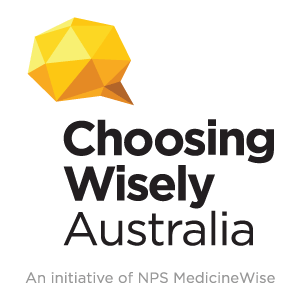Key points
- Low back pain is the leading cause of disability worldwide and its burden is growing.
- Around 90% of people who present with low back pain have non-specific low back pain, meaning no clear underlying cause can be identified.
- Non-specific low back pain is a diagnosis of exclusion which can be diagnosed clinically, through a targeted assessment, without imaging.
- A risk stratification approach can help reduce the risk of a patient developing chronic pain and disability.
- Education, reassurance and advice to stay active is first-line therapy for all patients. Medicines have a limited role, but can be an adjunct to support activity.
Gaming for chronic low back pain management

People with chronic non-specific low back pain are encouraged to exercise. But should gaming-based exercise (‘exergaming’) be considered exercise for chronic low back pain?
Low back pain podcast

Low back pain is a complex and challenging condition. It affects people of all ages and is the leading cause of disability in the world. Unfortunately, many of the common treatments we use to manage low back pain may not be as effective as we would like and have the potential to cause harm.
Join us for a conversation between Dr Jeannie Yoo, GP and NPS medical advisor, and Professor Chris Maher, one of the world’s leading researchers in back pain. Together, they discuss all things back pain: from imaging to physiotherapy; what works and what doesn’t.
Education and low back pain

A recent Australian study found that basic education in primary care is just as effective as intensive education for helping patients with acute non-specific low back pain.
Find out about what the study showed, how the media reported it and the education recommendations for low back pain.
Practice review – Low back pain: communication is key

Australian GPs recently received a Practice review about their requests for imaging of the lower back.
- Reflect on your data in relation to your patients and their indications for imaging.
- Find more information to help you interpret and understand your data.
- Access a sample report.
- Reflect on your data in relation to your patients and their indications for imaging.
- Find more information to help you interpret and understand your data.
- Access a sample report.
Medicinewise News: Patient-centred, pragmatic prescribing for acute non-specific low back pain

Managing acute non-specific low back pain can be a contradictory experience for healthcare professionals. On the positive side, acute non-specific low back pain is a self-limiting condition. On the challenging side, recent evidence shows that available medicines have little or no effect on this kind of pain. So how can a healthcare professional deal with patient expectations for pain relief?
Why tackle acute non-specific low back pain now?

Research shows that care for patients with acute non-specific low back pain could be improved by sticking more closely to guideline recommendations. These include:
- educating patients about their options
- providing assurance of a favourable prognosis, and
- encouraging patients to remain active and avoid bed rest.
Find out more about the background to this NPS MedicineWise visiting program
- educating patients about their options
- providing assurance of a favourable prognosis, and
- encouraging patients to remain active and avoid bed rest.
CPD options
Choosing Wisely Australia

Choosing Wisely Australia helps healthcare providers and consumers have important conversations about improving the quality of healthcare by reducing unnecessary and sometimes harmful tests, treatments, and procedures.
Led by Australia’s colleges, societies and associations and facilitated by NPS MedicineWise, Choosing Wisely Australia challenges the way we think about healthcare, questioning the notion 'more is always better'.
5 questions to ask your doctor or other healthcare provider is a resource that can help patients ensure they end up with the right amount of care.
See the Choosing Wisely recommendations for low back pain
Recommendation from the Royal Australian and New Zealand College of Radiologists
Recommendations from Faculty of Pain Medicine, ANZCA
Recommendations from Australasian Faculty of Rehabilitation Medicine
For your patients
Other resources
Patients with good computer literacy can create an action plan for themselves on the Arthritis Australia MyBackPain website.
5 questions to ask your doctor or other healthcare provider is a resource that can help patients end up with the right amount of care.
painHEALTH gives consumers access to reliable and usable evidence-informed information and skills to help them co-manage their musculoskeletal pain.
Clinical resources and tools
These tools screen for risk of chronic disability with low back pain:
- The STarT Back screening tool stratifies psychosocial risk for levels of pain, disability and distress as low, medium or high. A treatment package is then matched to each patient depending on their risk category. An uncomplicated (low risk) episode of low back pain may only require education and reassurance, whereas a patient with low back pain that is persistently debilitating may require assessment of psychosocial risk factors, mental health screening and referral for cognitive behavioural therapy.
- The Örebro Musculoskeletal Pain Screening Questionnaire was developed to identify patients at risk of developing persistent back pain problems and is also advocated for people with musculoskeletal work injuries.
- The PICKUP tool was developed to predict persistent pain in patients with a recent onset of low back pain.
Clinical guidelines
- Therapeutic Guidelines: Rheumatology: Low back pain
The Low back pain guidelines include detailed information on the diagnosis and management of non-specific low back pain. - NSW Agency for Clinical Innovation. Model of care. Management of people with acute low back pain
This Australian guideline recommends nine principles in the management of acute low back pain. Download a PDF copy. - NICE clinical guideline on low back pain and sciatica in over 16s
The 2016 UK National Institute for Health and Care Excellence (NICE) guidelines provide evidence-based information on the management of low back pain, including the limited role of imaging. See all NICE guidance on low back pain. - RANZCR education modules for appropriate imaging referrals
The Royal Australian and New Zealand College of Radiologists developed these education modules on appropriate imaging referrals for acute low back pain.
5 Questions to ask your doctor or other healthcare provider

Choosing Wisely Australia helps healthcare providers and consumers have important conversations about improving the quality of healthcare by reducing unnecessary and sometimes harmful tests, treatments, and procedures.
Led by Australia’s colleges, societies and associations and facilitated by NPS MedicineWise, Choosing Wisely Australia challenges the way we think about healthcare, questioning the notion 'more is always better'.
5 questions to ask your doctor or other healthcare provider is a resource that can help patients ensure they end up with the right amount of care.
Review papers
| Reference | Results and recommendations |
|---|---|
| Bardin L, King P, Maher C. Diagnostic triage for low back pain: a practical approach for primary care. Med J Aust 2017;206:268-273 | This narrative review provides current evidence for diagnostic triage for non-specific low back pain by excluding radicular syndrome and specific spinal pathology. Less than 1% of people presenting with low back pain have an underlying serious spinal pathology that may require imaging. Around 10% have radicular syndrome, and around 90% have non-specific low back pain that does not require imaging, unless the patient has rapidly deteriorating neurological status. The review includes a table of alerting features for specific spinal pathologies and the recommended diagnostic workup. The traditional approach to management of non-specific low back pain was first to stratify by duration of symptoms and then begin with simple care and progress to more complex care if insufficient progress was made. A more recent approach is to use validated risk stratification tools – such as the STarT Back screening tool or the Örebro Musculoskeletal Pain Screening Questionnaire – to stream patients into different care pathways. An uncomplicated (low risk) episode of low back pain may only require education and reassurance whereas for patients with high risk scores, additional treatment with more intensive interventions such as physiotherapy or even cognitive behavioural therapy may be required. |
| Maher C, Underwood M, Buchbinder R. Non-specific low back pain. Lancet 2017;389:736-747 | This article includes information on global epidemiology of non-specific low back pain. A differential diagnosis section supports the diagnostic triage of low back pain, noting that non-specific low back pain implies no known pathoanatomical cause. The article reinforces the idea that clusters of alerting features (red flags) are more predictive of a serious spinal pathology than individual features. Imaging has no role in low back pain except when there are major risk factors for cancer, risk factors for spinal infection or cauda equina syndrome. Patient education can be effective for outcomes such as return to work and global impression of recovery. Bed rest should be avoided, and the patient should remain as active as possible, gradually resume their normal activity levels and if possible remain at work. When considering medicines, the potential benefits should be weighed against the harms. Non-pharmacological therapies for acute low back pain include treatments such as manual therapy, exercise and massage. The article includes two tables that summarise the evidence from systematic reviews about the effects of treatments for acute low back pain on short-term pain outcomes. |
| Hartvigsen J et al. What low back pain is and why we need to pay attention. Lancet 2018;391:2356-2367 | This article details the differential diagnosis of radicular syndrome and specific pathological causes, and reinforces clusters of alerting features. 80% of people with acute low back pain have at least one alerting feature despite less than 1% having a serious spinal pathology. The very low specificity of of most alerting features contribute to unnecessary imaging. Imaging can be delayed in the presence of weak risk factors for cancer and axial spondylarthritis, pending a trial of conservative therapy. The review includes a summary of the biopsychosocial understanding of risk factors for developing chronic disabling pain in people with acute non-specific pain. This includes a table of selected predictors and association with poor outcomes. |
Diagnosis
| Reference | Results and recommendations |
|---|---|
| Chou R et al. Imaging strategies for low-back pain: systematic review and meta-analysis. Lancet 2009;373:463-472 | This systematic review and meta-analysis analysed randomised controlled trials that compared immediate lumbar imaging (radiography, MRI, or CT) versus usual clinical care without immediate imaging for low back pain. Results showed no significant differences between immediate lumbar imaging and usual care without immediate imaging on pain and function. There was also no significant difference in quality of life, mental health and overall patient-reported improvement. |
Wheeler L, Karran E, Harvie D. Low back pain: Can we mitigate the inadvertent psycho-behavioural harms of spinal imaging? Aust J Gen Pract 2018;47:614-17 | This article encourages primary care clinicians to engage in thoughtful use of imaging procedures, and to consider alternative or adjunct methods for providing reassurance, in order to avoid or mitigate the potential negative impact of ‘anomalous’ findings. The article recognises that while imaging is frequently requested with the goal of reassuring patients, it can paradoxically have a negative impact on patient attitudes and beliefs and can influence pain behaviours. |
| Ferreira G et al. Limited evidence for screening for serious pathologies using red flags in patients with low back pain presenting to the emergency department. Emerg Med Australas 2018;30:436-437 | This letter to the editor recognises that many alerting features have very high false positive rates. As an example, night pain is present in 50% of back pain patients with no serious disease. The only Cochrane reviews in this area demonstrate that the evidence is sparse and the evidence available suggests that many endorsed alerting features to screen for serious pathology have likelihood ratios close to 1.0 and so are uninformative. |
Management
| Reference | Results and recommendations |
|---|---|
| Almeida M et al. Primary care management of non-specific low back pain: key messages from recent clinical guidelines. Med J Aust 2018;208:272-275 | This article summarises recommendations from recently published UK, Danish, Belgian and US guidelines to identify important changes. The UK NICE and Belgian guidelines recommend simple risk prediction tools to match patients to treatment packages based on their risk of poor clinical outcomes. These include: These tools are freely available online and currently it is unclear which is most effective. All guidelines recommend advice, reassurance and encouragement of physical activity as first-line care for all patients with non-specific low back pain. Guidelines have a greater emphasis on non-pharmacological management, with pharmacological options reserved for those whose pain does not respond. For patients at medium to high risk, based assessment with the stratification tools, the guidelines endorse more complex and intensive treatments. |
| Foster NE et al. Prevention and treatment of low back pain: evidence, challenges, and promising directions. Lancet 2018;391:2368-83. | The second paper in the Lancet’s series on low back pain discusses evidence, challenges and promising directions for prevention and treatment of low back pain. All guidelines recommend self-management, physical and psychological therapies in management of low back pain and place less emphasis on pharmacological and surgical treatments. Routine use of imaging is not recommended, and very little prevention research exists. |
| Chou R, Shekelle P. Will this patient develop persistent disabling low back pain? JAMA 2010;303:1295-1302 | This study systematically reviews the usefulness of individual risk factors or risk prediction instruments for identifying patients more likely to develop persistent disabling low back pain. Results showed that presence of non-organic signs, high levels of maladaptive pain coping behaviours, high baseline functional impairment, presence of psychiatric comorbidities and low general health status were the most useful predictors of worse outcomes at 1 year. Low levels of fear avoidance and low baseline functional impairment were the most useful items for predicting recovery at 1 year. |
This is the original validation study for the STarT Back tool. The 2008 Hill study provides the rationale and findings for the initial development of the tool, the purpose of which was to identify patients at risk of poor prognosis. The 2011 Hill study provides the actual tool and the Keele University webpage provides information on use and scoring, and treatments matched to risk levels. STarT Back is considered the primary example of available tools, because:
| |
| Dahm KT et al. Advice to rest in bed versus advice to stay active for acute low-back pain and sciatica. Cochrane Database Syst Rev 2010;16;CD007612 | This Cochrane review is the key study providing evidence in support of the recommendation for patients to stay active as much as possible. Patients with acute non-specific low back pain can experience small benefits in pain relief and functional improvement from advice to stay active, compared with advice to rest in bed. Furthermore, evidence suggests little or no difference between those who received advice to stay active, exercise or physiotherapy, which highlights that any movement is beneficial. The authors stated that none of the included studies reported significant side effects of bed rest, but adverse physiological effects of bed rest have previously been reported. These results may be relevant to consider in clinical practice, and further demonstrate that advice to rest in bed should be avoided for patients with acute low back pain. |
| Qaseem A et al. Noninvasive treatments for acute, subacute, and chronic low back Pain: A Clinical Practice Guideline from the American College of Physicians. Ann Intern Med 2017;166;514-30 | This guideline from the American College of Physicians presents the evidence and clinical recommendations for non-invasive treatment of low back pain. It provides a succinct summary of evidence for non-pharmacological therapies. There is low- to moderate-quality evidence showing mixed results for managing back pain with massage and spinal manipulation. The guideline clearly recommends superficial heat. In particular it finds that of all the different types of superficial heat, only a heat wrap has evidence of benefit for acute non-specific low back pain. This is moderate evidence from a small number of trials. It found the evidence for superficial cold insufficient. |
Traeger AC et al. Avoid routinely prescribing medicines for non-specific low back pain. Br J Sports Med 2018;pii: bjsports-2017-098614 | This education review provides a summary of recent changes and evidence for commonly used medicines in non-specific low back pain, and recommends:
|
Guidelines
| References | Results and recommendations |
|---|---|
| Australian Therapeutic Guidelines. Low back pain. 2017 | The guidelines provide information on assessment of radicular syndrome and alerting features of serious spinal pathologies. They reiterate that a precise anatomical diagnosis is usually not necessary, or possible. However, a physical examination is still important to identify alerting features of serious pathologies and neurological signs, and to understand the patient's spinal movement patterns and limitations. Radiological findings are poorly correlated with symptoms in patients with low back pain. Risk factors for poor prognosis include a high level of pain and disability at presentation, leg pain, older age, poor general health, psychosocial factors (eg mental stress, anxiety, depression), and reduced cognition. The guidelines recommend the use of the STarT Back tool or Örebro Musculoskeletal Pain Questionnaire. Management includes graded exercise and non-pharmacological management, including thermotherapy and massage. The following passive physical treatments are not recommended for non-specific low back pain because evidence does not support a benefit: acupuncture, spinal manipulative therapy, lumbar supports, transcutaneous electrical nerve stimulation (TENS), laser therapy, traction, electromyographic biofeedback, therapeutic ultrasound or short-wave diathermy. The guidelines recommend ensuring other components of non-specific low back pain management, in particular patient education and reassurance, have been implemented before considering pharmacological management. The goal of pharmacological management is to reduce, rather than abolish, pain so that physical function can be maintained. |
| NSW Agency for Clinical Innovation. Model of care Management of people with acute low back pain. 2016 | This is an Australian guideline that provides principles for the management of acute low back pain, including:
|
| National Institute for Health and Care Excellence. Low back pain and sciatica in over 16s: assessment and management. Assessment and non-invasive treatments. 2016 | The 2016 UK National Institute for Health and Care Excellence (NICE) provides evidence-based information on the management of low back pain. The guideline provides the evidence about the limited role of imaging only if it changes management, as well as the STarT Back Screening tool and the Örebro Musculoskeletal Pain Screening Questionnaire. The guideline moves away from the traditional analgesic ladder and advises only two options: oral NSAIDs at the lowest effective dose for the shortest time possible and the use of a weak opioid (with or without paracetamol) if the patient does not tolerate or their pain does not respond to an NSAID. The guideline also provides evidence on exercise and non-pharmacological management like manual therapies. |
| Belgian Health Care Knowledge Centre. Low back pain and radicular pain: assessment and management. 2017. | Belgian guidelines 2017 provide a recent review of risk assessment tools and risk stratification. These guidelines provide a recent review of the evidence on risk assessment tools, and supports the use of these tools in the management of acute non-specific low back pain. |
| Qaseem A et al. Noninvasive treatments for acute, subacute, and chronic low back Pain: A Clinical Practice Guideline from the American College of Physicians. Ann Intern Med 2017;166;514-30 | This guideline by the American College of Physicians presents the evidence and clinical recommendations for non-invasive treatment of low back pain. It provides a succinct summary of evidence for non-pharmacological therapies. |
| Goergen S et al. Acute low back pain. Education modules for appropriate imaging referrals: Royal Australian and New Zealand College of Radiologists; 2015 | These RANZCR education modules provide information on appropriate imaging referrals for acute low back pain. There is a an imaging decision flow chart and detailed information on ruling out serious spinal pathology. |
| Chou R et al. Diagnosis and treatment of low back pan: A joint Clinical Practice Guideline from the American College of Physicians and the American Pain Society. Ann Intern Med 2007;147:478-491 | This clinical practice guideline outlines recommendations for diagnosing and managing low back pain.
|
